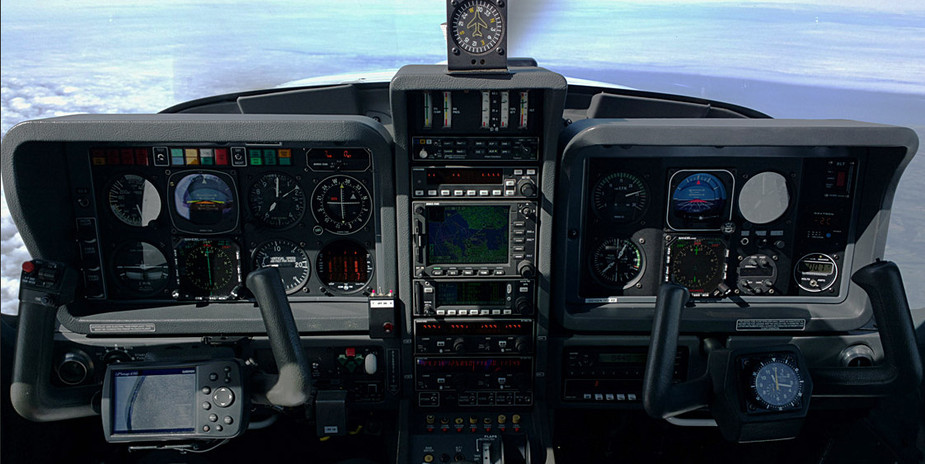I regard my EDM700 as really important and have had it rebuilt from the original 2.25" version to the larger 3.125" size, and moved it to the pilot side, replacing the original KI229 RMI

It can also give an early warning of fuel system icing issues – example 
However one can get overly fixated on tiny variations. For example sometimes I get a “walkabout” on the EGTs, of about 10-15F peak to peak. This is on all cylinders, and is not the often publicised (by GAMI) valve rotation issue. It seems to relate mainly to the wingtip strobe being on. But the variation is only 1% of full-scale and on an analog instrument you would never see it!
I watch the engine instruments regularly and sometimes compare the EDM 700 with the conventional gauges. In addition to the EDM I use the JPI 450 Fuel Scan, which is very accurate. Setting the correct Fuel flow gives me the correct TIT on the EDM without further delay. Also it shows me Fuel aboard, used and remain.
And no, we are not too fixated on engine monitoring instruments, since in a SEP detection of any anomaly can be very important for the engine, the aircraft and the people on board. I see the engine instruments as just as valuable as the instruments for flight control.
I am just having a very basic aircraft refurbished, and so I’m putting in a CGR30-P. I think you can’t have too much information, and this instrument replaces all the required engine instruments plus a load more.
The engine is the only thing keeping you in the air….seems like you will wanna make sure it’s happy during all phases of flight.
A few years back a doctor I know said that he was getting so much information from some medical tests that the volume of data was hiding the facts that he needed to know.
I can’t help feeling that some of these engine monitors are getting so sophisticated that they are hiding facts that a pilot needs to know ……………… Such as the rapidly growing opposite direction aircraft that is front and centre in the windscreen ! ( probably also fitted with the latest engine monitor !)
A_and_C wrote:
A few years back a doctor I know said that he was getting so much information from some medical tests that the volume of data was hiding the facts that he needed to know.
I think this doctor is right. A couple of days ago, Peter posted a picture of a new KingAir glass cockpit with 10 dials per engine. Who is going to monitor all these dials and more important: Who is going to make any sense of what he’s looking at in the short time available? After all, we don’t go flying to look at engine dials.
Not one of my four engine failures (3 piston, one turbine) would have announced itself early through any of these engine dials (ruptured valve rocker – misfiring magneto – turbocharger broken off the exhaust manifold – ruptured turbine blade due to manufacturing defect). One moment the engine was running, the next moment it was not. Monitoring the instruments would not have made the least difference.
Therefore I don’t pay too much attention to engine instruments any more. The real important things will be announced by warning and “master warning” / “master caution” lights anyway. A glance every couple of minutes if everything is in the green arc is all I do.
A_and_C wrote:
A few years back a doctor I know said that he was getting so much information from some medical tests that the volume of data was hiding the facts that he needed to know.
Ideally all a pilot needs to know is %power or thrust. The ECU should handle the rest and only inform if something is wrong.
There is also a difference between certified and non-certified in this regard. Through the certification the operation of the engine is mapped so you don’t need all these measurements. You simple operate it as per the manual of the aircraft. For experimentals you can use any engine, and you will actually need as much instrumentation as possible to be sure the engine is OK. Still, there is no need to display everything all the time, the EMS can be configured with alarms and so on.
what_next wrote:
A glance every couple of minutes if everything is in the green arc is all I do
So you ARE monitoring all these dials! 


what_next wrote:
A couple of days ago, Peter posted a picture of a new KingAir glass cockpit with 10 dials per engine.
Not quite, actually worse – a glass cockpit that replicated the ten (5 per engine) dials you have in any PT6 aircraft, and replicated them on each side.
The “glass” engine monitor is a HUGE opportunity to have everything “dark” unless something is outside the expected range, or rapidly heading there. So there should be a “percent power” indicator and nothing else. And for the piston folks, something indicating the mixture, ideally a measured lambda (mixture ratio) rather than the ancient EGT-peak method of setting a mixture.
Unfortunately, the actual products appear to be designed by geeks for geeks, who want to see everything….
what_next wrote:
The real important things will be announced by warning and “master warning” / “master caution” lights anyway.
That may be true for a turbine aircraft, but if you want your piston engine to make or exceed TBO, you need to monitor CHTs and TIT (if it is a turbo). And getting meaningful values there is only possible with an engine monitor that measures each cylinder separately. Yes, once you have set everything correctly I don’t think you need to monitor all the gauges all the time, just the hottest CHT and TIT, and oil pressure would be values that can really alert you before something bad happens.